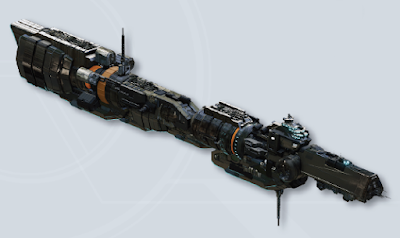Last time I looked at the profitability of a 200-ton Far Trader.
So this time’ I’m looking a bit bigger and I’m considering the cargo carrier, a 3000 dton ship with 44 staterooms (30 passengers) and a 1,100.5 cargo bay.
Do the economics stack up? TL;DR: Yes!
Cargo Carrier
Mongoose's High Guard has a 3000-ton Cargo Carrier with 44 staterooms and 1,100.5 tons of cargo space. The full details are in High Guard, but here’s the description:
The Al Morai corporation maintains a fleet of 53 type MK Mora cargo carriers (not enough to receive the discount for standard designs), plying fixed routes of select Class A and B starports throughout the Spinward Marches, armed and accompanied by surplus Gazelle close escorts as deterrents to piracy. Generally named for systems along the route, these freighters maximise cargo space by using a cramped bridge, an undersized power plant that requires dimming ship’s power when initiating a jump-4, turrets controlled via software and fuel/cargo containers to maximise cargo on shorter jumps. Al Morai facilities at each stop supply refined fuel, so no processors are installed. Two pinnaces for ferrying of passengers and cargo, and for emergency use as lifeboats. The ship has 14 rooms for crew (single occupancy for the captain, chief engineer and medic; double occupancy otherwise) and 30 passenger staterooms.
The design is a bit confusing because, at first glance, it doesn't appear to have enough fuel - it has only a 548 dton fuel tank – but a closer inspection reveals 540 tons of combined fuel/cargo containers.
Even then, something’s not right. The cargo carrier needs 540 tons for jump 2 (decreased fuel x 2) and 76 tons for the power plant, so the 548 dton fuel tank should be 68 tons more (to 716 dtons). So for my calculations I’ve shrunk the cargo space by 68 dtons: At jump 2, the cargo carrier can haul 1572.5 dtons of cargo.
(It’s possible I’ve got that wrong – Traveller ship design is incredibly fiddly. So if the original numbers are right, then that means the cargo carrier uses less fuel than I’ve calculated and carries more cargo. But my numbers are probably close enough.)
Let’s trade!
If we fill that 1572.5 cargo bay with freight and fill the 30 staterooms with 15 high and 15 middle passengers, then our income is Cr 5,752,000 per four weeks.
Our four-weekly running costs are Cr 5,009,802, including mortgage. (I've assumed refined fuel because the idiot architects didn't install fuel processors.)
That gives a monthly profit of Cr 742k! (Less any taxes and things that aren’t considered.)
So that does assume that I fill the cargo bay and staterooms. That’s fairly easy between Mora and Fornice – but not elsewhere. (Mind you, I suspect the core book’s freight tables are aimed at smaller ships rather than huge cargo carriers like this.)
The break-even point on the ship is about 88% capacity. For example, with 90% cargo and passengers, then the profit is only Cr 118k. It would be easy to go into the red if you stray away from the profitable routes. (So I would expect remote routes to pay a premium to make them worth servicing.)
And what about Jump 4?
Jump 4 is much more profitable because although the Cargo Carrier sacrifices cargo space for fuel, the shipping and passage rates more than double.
- Cargo: Cr 4400/dton compared to Cr1600/dton – a 275% increase.
- High passage: Cr34,000 compared to Cr 14,000 – a 242% increase.
- Medium passage: Cr23,000 compared to Cr10,000 – a 230% increase.
Even though fuel costs have increased, a full cargo carrier generates Cr 5.2M profit every month!
That’s if you can find a good route, of course.
Jump 4 is also much more resilient – the cargo/passenger capacity only needs to be a little over half full to pay for the cargo carrier’s operating costs.
But Gazelle Close Escorts?
Mind you, I’m not sure who’s paying for the Gazelle Close Escorts (plural) that, according to the High Guard description, accompany the cargo carrier.

To get the background on Al Morai, you need to go back to Classic Traveller's "The Spinward Marches Campaign". It doesn't mention how many Gazelle class escorts they have, but I expect it is significantly fewer than the number of Mora/World class transports; I would expect them to operate mainly in the border regions (Aramis, Regina, Jewell, Lanth, etc) where piracy/corsairs are more likely.
ReplyDeleteAs for their routes, TSMC says that they follow the X-boat network (Well, it doesn't say that, but the route map is identical) with facilities only at A and B class starports. Which, of course, implies that the economics of ships owned by corporations need to consider costs beyond those of independent free traders. Counter to that, they have lower costs due to being well established with ships that are mortgage free. Additionally, as they operate regular routes, they can pretty much guarantee full holds and passenger lists in advance, only looking on the local market if they have surplus capacity.
Yes, good points. I expect Al Morai gets cheaper loans than a regular ship mortgage as well.
ReplyDelete